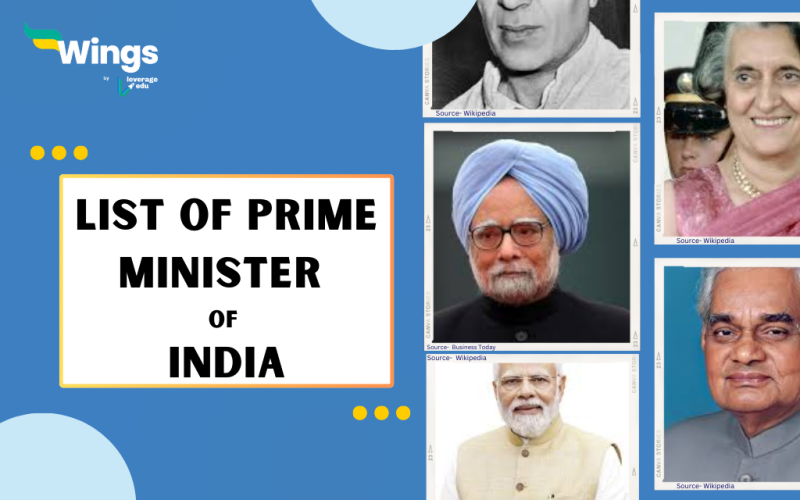The Prime Minister of India list from 1947 to 2024 contains the names of revolutionary leaders who have shaped India’s journey since independence. From memorable leaders like Manmohan Singh to contemporary famous personalities of India such as Narendra Modi, India has witnessed the governance of 15 Prime Ministers from 1947 to 2024. The Prime Minister of India list from 1947 to 2020 or 2024 can help students study smarter and not longer. So, if you are also trying to find the complete list with the necessary details, you are at the right place. In this blog, you will find the ultimate Prime Minister of India List from 1947 to 2024 with names, tenure, and photos.
This Blog Includes:
Complete List of Prime Ministers of India
In this section, you will find read the list of Prime Ministers of India along with their term and major contributions. From Jawaharlal Nehru as India’s first Prime Minister to Narendra Modi serving as the Prime Minister for 3 consecutive terms, this list is full of useful information that can help you enhance general knowledge for competitive exams.
| Name | Term as the Prime Minister | General Trivia or Fact |
| Shri Narendra Modi | May 26, 2014 to Present | Known for campaigns like Swachh Bharat, Make in India, Digital India, and winning the Seoul Peace Prize in 2018. |
| Dr. Manmohan Singh | May 22, 2004 to May 26, 2014 | Implemented NREGA, Right to Information Act, and carried out major economic reforms. Signed the nuclear civil deal with the USA. |
| Shri Atal Bihari Vajpayee | May 16-31, 1996March 19, 1998 to May 13, 2004. | The first Prime Minister since Pandit Jawaharlal Nehru to have become Prime Minister of India with two successive mandate. |
| Shri Inder Kumar Gujral | April 21, 1997 to March 19, 1998 | Known for the Gujral Doctrine, which shaped India’s foreign policy. |
| Shri H. D. Deve Gowda | June 1, 1996 to April 21, 1997 | Focused on farmers’ issues and contributed to the Delhi Metro project. |
| Shri P. V. Narasimha Rao | June 21, 1991 to May 16, 1996 | Implemented major economic liberalization and globalization reforms, contributing to India’s economic growth. |
| Shri Chandra Shekhar | November 10, 1990 to June 21, 1991 | Led India through the economic crisis and prevented a sovereign default. |
| Shri V. P. Singh | December 2, 1989 to November 10, 1990 | Implemented the Mandal Commission Report and passed the Scheduled Caste and Scheduled Tribe Act. |
| Shri Rajiv Gandhi | October 31, 1984 to December 2, 1989 | Promoted science, technology, and higher education reforms, and was instrumental in ushering in the computer revolution in India. |
| Chaudhary Charan Singh | July 28, 1979 to January 14, 1980 | Advocated for farmers and is remembered for his contributions to agricultural reforms. |
| Shri Morarji Desai | March 24, 1977 to July 28, 1979 | Implemented the Forty-fourth Amendment of the Indian Constitution. |
| Smt. Indira Gandhi | January 24, 1966 to March 24, 1977 | January 14, 1980 to October 31, 1984 |
| Shri Lal Bahadur Shastri | June 9, 1964 to January 11, 1966 | Promoted the White and Green Revolutions and coined the slogan ‘Jai Jawan, Jai Kisan’. Led India to victory in the 1965 India-Pakistan war. |
| Shri Gulzarilal Nanda | May 27, 1964 to June 9, 1964 | January 11, 1966 to January 24, 1966 |
| Shri Jawaharlal Nehru | August 15, 1947 to May 27, 1964 | Founder of modern India, initiated industrial and technological development, and promoted education. His birth anniversary is celebrated as Children’s Day. |
Do Check Out:
- Home Minister of India: Famous Personalities Responsibilities, Appointment
- Who Was The First Home Minister Of India?
- Who Was The First Education Minister Of India?
- Who Was The First Governor General Of Free India?
1. Narendra Modi (2014- Present)
Shri Narendra Modi was sworn in as India’s Prime Minister for the third time on June 9, 2024, following a decisive win in the 2024 elections. This milestone made him the first Prime Minister to serve three consecutive terms. Under his leadership, India has seen significant advancements in economic growth, national security, and social welfare programs. A key highlight of his leadership is the implementation of initiatives like Ayushman Bharat, Jan Dhan Yojana, and the Swachh Bharat Mission, which have transformed the lives of millions across the country.

| Particulars | Details |
| Full name | Narendra Damodardas Modi |
| Born on | 17 September 1950 |
| Tenure as Prime Minister | 2014- till now |
| Political Affiliation | Bharatiya Janta Party |
1. Manmohan Singh (2004 – 2014)
Dr. Manmohan Singh, India’s 14th Prime Minister, was a respected thinker and scholar. Born on September 26, 1932, in Punjab, he had an exceptional academic career, studying at prestigious universities like Cambridge and Oxford. Known for his leadership and vision, he played a major role in India’s economic reforms in the 1990s. Dr. Singh served as Prime Minister from 2004 to 2014 and received several awards for his contributions. He is remembered for his humility, academic approach, and dedication to India’s progress. Dr. Singh passed away on December 26, 2024.

| Particulars | Details |
| Born on | 26 September 1932 |
| Died | 26 December 2024 |
| Tenure as Prime Minister | 2004 – 2014 |
| Political Affiliation | Indian National Congress |
3. Atal Bihari Vajpayee (1998 – 2004)
Atal Bihari Vajpayee, born on December 25, 1924, in Gwalior, was a prominent leader of the Bharatiya Janata Party (BJP) and served as India’s Prime Minister twice (1996; 1998-2004). Known for his diplomatic skills, he improved relations with Pakistan and China. Vajpayee led India through nuclear tests in 1998 and initiated significant economic reforms. Despite challenges, his leadership helped India grow in the IT sector. He retired from politics in 2005 and was awarded the Bharat Ratna in 2014. Vajpayee passed away on August 16, 2018.

| Particulars | Details |
| Born on | December 25, 1924 |
| Died | August 16, 2018 |
| Tenure as Prime Minister | 1998 – 2004 |
| Political Affiliation | Janata Party |
4. Shri P. V. Narasimha Rao (1991 – 1996)
P.V. Narasimha Rao was the Prime Minister of India from 1991 to 1996. Known for his role in transforming India’s economy, he introduced economic reforms that shifted India to a free-market system, boosting industrial growth and foreign investment. Rao was fluent in six languages and was a scholar. He received the Bharat Ratna posthumously in 2024 for his contributions to India’s progress. He passed away on December 23, 2004, leaving a lasting impact on the country.

| Particulars | Details |
| Full name | Pamulaparti Venkata Narasimha Rao |
| Born on | June 28, 1921 |
| Died | December 23, 2004 |
| Tenure as Prime Minister | 1991 – 1996 |
| Political Affiliation | Indian National Congress |
5. Shri Chandra Shekhar (1990 – 1991)
Chandra Shekhar, born on April 17, 1927, in Uttar Pradesh, was a prominent political leader known for his idealism and revolutionary spirit. He was a member of the Janata Party and served as its President from 1977 to 1988. He worked for social change and fought for the rights of the downtrodden. During the Emergency in 1975, he was imprisoned for his dissent. Chandra Shekhar also led a 4,260 km walk across India to connect with the people and understand their issues. He remains remembered for his dedication to democracy and social reform.

| Particulars | Details |
| Born on | July 1, 1927 |
| Died | July 8, 2007 |
| Tenure as Prime Minister | 1990 – 1991 |
| Political Affiliation | Janata Party |
FAQs
India has had 15 prime ministers from 1947 to 2024, starting with Jawaharlal Nehru and continuing to the current prime minister. Each leader has played a significant role in shaping India’s political and economic landscape.
In 2024, Narendra Modi is the Prime Minister of India. He has served as PM since 2014 and is known for various initiatives like Swachh Bharat Abhiyan and Digital India.
India has had 15 prime ministers so far, and there hasn’t been a 19th prime minister yet. The count includes leaders who served multiple terms.
Narendra Modi has served as the Prime Minister of India for three consecutive terms. He became PM in 2014, was re-elected in 2019, and continues to lead the nation in 2024. His tenure is marked by key initiatives like Digital India, Make in India, and Swachh Bharat Abhiyan.
The title of “No. 1 CM” in India varies and is subjective. As of now, leaders like Naveen Patnaik of Odisha and Arvind Kejriwal of Delhi are often praised for their governance.
There is no maximum age limit to become the Prime Minister of India, but the candidate must be at least 25 years old to be a member of the Lok Sabha.
There are 28 states and 8 union territories in India. Each state has its own chief minister, such as Yogi Adityanath in Uttar Pradesh and Mamata Banerjee in West Bengal. For a full list, refer to official state government updates.
Read More Blogs on Indian Politics
Hope you enjoyed reading about the Prime Minister of India list from 1947 to 2024 with tenure and photo. If you want to know more about other Famous Personalities then visit our General Knowledge page! Stay connected with Leverage Edu for more such interesting blogs.

 One app for all your study abroad needs
One app for all your study abroad needs





















 45,000+ students trusted us with their dreams. Take the first step today!
45,000+ students trusted us with their dreams. Take the first step today!


